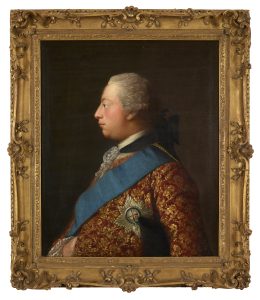Rare portrait of Queen Charlotte made famous in Bridgerton goes under the hammer
Two rare portraits featuring King George III and his consort Queen Charlotte, whose story has been popularised by hit Netflix series Bridgerton, are to go under the hammer.
The paintings by celebrated Scots-born artist Allan Ramsay are estimated to fetch between £25,000 – £30,000.
They will be offered live in Edinburgh and online by fine art auctioneers, Lyon & Turnbull, on 7 December.
Queen Charlotte’s rise to power was brought to our screens this year when Netflix released a spin-off series from the hugely popular television show, Bridgerton.
The six-part drama, and its portrayal of the Queen, led to renewed interest in the monarch, who was born in 1744 in Mecklenberg-Strelitz, now part of Germany.
The 17-year-old Princess married King George six hours after her arrival in London in September 1761.

Credit Stewart Atwood/Lyon & Turnbull
Ramsay’s portraits of the royal couple, who had 15 children (13 of whom survived into adulthood), were painted soon after their marriage.
It was a pairing which lasted 57 years and made Queen Charlotte Britain’s longest serving Queen consort.
Nick Curnow, Head of Fine Arts at Lyon & Turnbull said: ‘It’s exciting to see such magnificent paintings come to market.
‘Under the prolific patronage of George III, Ramsay’s royal portraiture established an iconography that would define the monarch’s reign throughout the globe for generations to come.’
Allan Ramsay, from Edinburgh, is known as the golden boy of Georgian portraiture.
His artistic talent, as well as his social flair and great intellect, earned him elite patronage.
He counted major figures of the Georgian era, such as David Hume, Adam Smith, Samuel Johnson and James Boswell, among his close coterie of friends.

Credit Stewart Atwood/Lyon & Turnbull
The pivotal moment of Ramsay’s career came when the 3rd Earl of Bute, John Stuart, who went on to serve as Britain’s Prime Minister between 1762-1763, commissioned Ramsay to paint a full-length portrait of his pupil George, then Prince of Wales.
The young Royal was so pleased with the likeness that he, in turn, commissioned a portrait of his esteemed teacher.
This marked the start of a royal patronage which led to Ramsay being asked to produce Coronation portraits of the King and Queen.
The Lord Chamberlain’s Office required numerous copies of these paintings to be distributed to ambassadors and governors across the world; this task would occupy Ramsay and his studio assistants for the rest of his life.
In around 1761-1762, Ramsay recorded working on smaller pendant portraits of King George and Queen Charlotte in profile “for the coinage” (to be used on coins).
In these rare paintings the King is presented in full regal splendour, wearing the star and ribbon of the Order of Garter.
Queen Charlotte is equally refined, draped in lace with pearls round her neck with a cream ribbon. Again the 3rd Earl of Bute commissioned the first versions of these portraits.
Ramsay went on to be made Principal Painter to the King in 1767.
Don’t miss the December issue of Scottish Field magazine
TAGS

